Nanjing Ming City Wall--Walking on the City Wall on the 16th of the first month
Walking time: 2021.2
Walking method: Walking
Walking route: Yifeng Gate → Yijiangmen → Huayangang Gate → Dinghuaimen Dengchengkou
Address: The city wall in the northwest section of Gulou District, Nanjing City
Tickets: None
On New Year's Eve, I accidentally bumped into the Zhonghua Gate Tower. Several exhibitions were held in the Zhonghua Gate Tower using the Zangbing Cave, which allowed us to sigh at the architectural and military design of the Zhonghua Gate while also gaining a lot of knowledge. For example, I learned about the Spring Festival customs in Nanjing. Although I have lived in Nanjing for decades, I really know very little about the customs of old Nanjing. The old Nanjing custom of "On the 16th of the first lunar month, we will walk away from all kinds of diseases" tells the story that Nanjing people will climb the city wall to get rid of the diseases on the 16th of the first lunar month. It contains the hope of eliminating all kinds of diseases and being healthy and safe in the coming year. So he planned early on to find a section of the city wall to walk on this day. The child chose Yifeng Gate in the north of the city to climb the city wall.

Yifeng Gate, which spans Jianning Road, is one of the thirteen Ming Dynasty capital gates on Nanjing's Ming City Wall. It was built in the early years of Hongwu of the Ming Dynasty and was named Yifeng Gate because of the meaning of phoenix coming to the ceremony. The gate faces east to west, taking the shape of a dragon and phoenix shining auspicious. In the old days, Yifeng Gate was a single-hole gate, and the two wings of the city wall were built along the mountain. The north side was surrounded by Lion Mountain and the south side was surrounded by Hydrangea Mountain. The gate was built between the two mountain depressions to take advantage of geographical location. Two water caves were built under the city, and the military position is very important. From 1958 to 1959, the city demolition movement sweeping across the country spread to Nanjing. Yifeng Gate was demolished, but the city walls on both sides were intact. In 2006, Yifeng Gate was rebuilt and the city walls on both sides were reconnected. The rebuilt Yifeng Gate was changed into a three-hole gate for convenient transportation. The middle hole is slightly larger and passes through the fast lane. The two holes on both sides are slightly smaller and pass through the slow lane. There is a Ming Dynasty official architectural style tower on the gate.

On the north side of the city gate is the archway of the "Range Rover Crossing the River".

Behind the archway is the "South Gate", which is the south gate of Yuejiang Tower Scenic Area. You need to buy a ticket here to visit Yuejiang Tower.

We did not go to Yuejiang Tower, but directly found the ramp leading to the Ming City Wall and climbed to the tower.

On the platform of the city wall there is a tower with carved beams and painted buildings with double eaves and a mountain top. The city tower is now the Yifeng Book Pavilion, but General Tie has the door.

Standing under the tower and looking at Jianning Road. On the north side of Jianning Road is Tianfei Palace, and further away is Jinghai Temple. Yifeng Gate is the main road leading to the bank of the Yangtze River in the north of Nanjing. Historically, it was an important gate for the court to cross the river. Officials at that time used this gate when they went north and went on expeditions. When a battle is won, nearby people will hold a grand ceremony near Yifeng Gate to welcome the victorious soldiers. It is still one of the main corridors connecting the north and south.

The city wall on one side surrounds Lion Rock, Tianfei Palace and Jinghai Temple at the foot of the city wall. Everything here is a precipitation of thickness and vicissitudes.
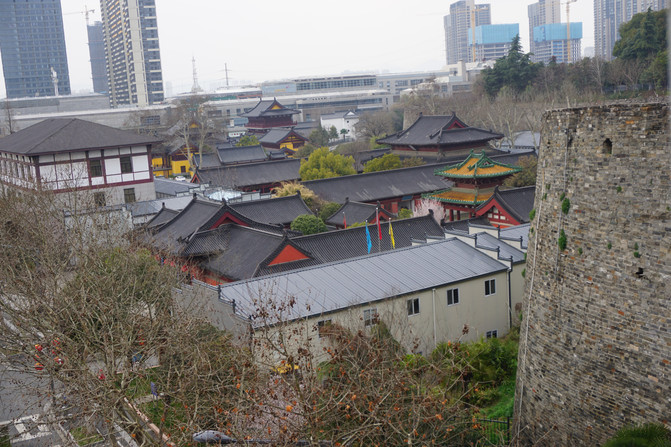
Looking at the street view from the city wall,

Climbing the city wall, from another perspective, the city will be more imposing.
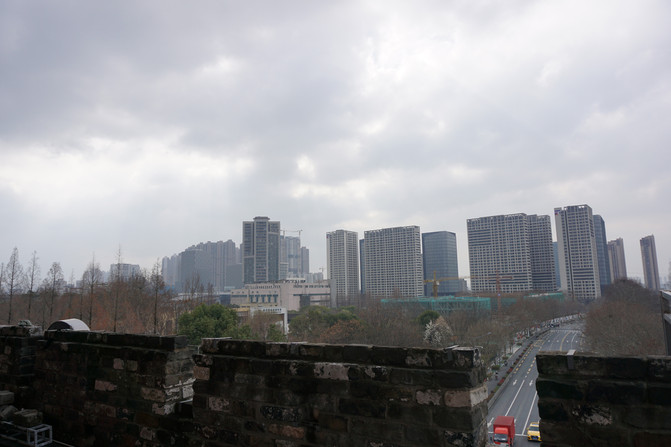
To the north of the city wall is the Yuejiang Tower Scenic Area. The roads are impassable. The city wall continues to walk south.

Looking back at Lion Rock from this turning city wall, the winding city wall. The tower on the city wall echoes each other with the Yuejiang Tower on Lion Mountain.

After a few steps, the city wall is towering and stretching, and the Yuejiang Tower stands aloof, just like two majestic men guarding it

The majestic city wall turns along the mountain.

Soft flowers on the city wall
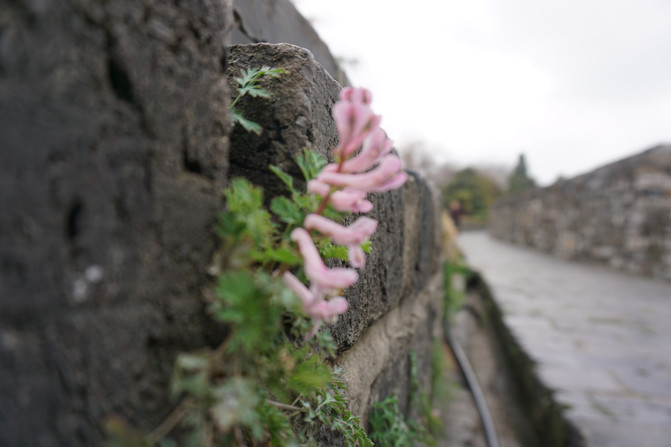
Yifeng Square under the city wall

Walking south from the Yifeng Gate City Wall, the road on this section of the city wall is relatively narrow, with lush vegetation and simple wall bricks.
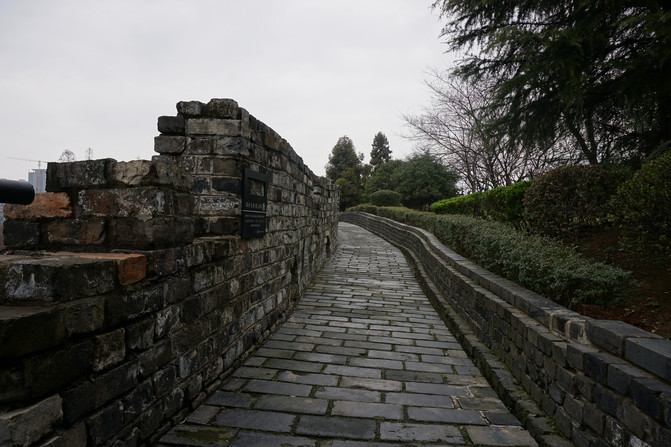
Looking back at the winding place
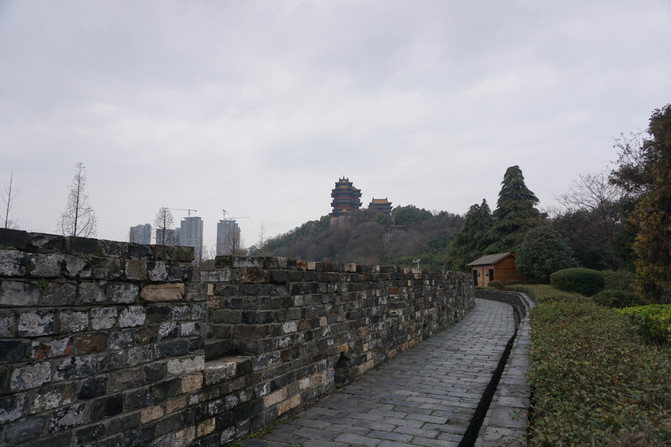
The city wall is undulating in height. This section of the city wall is the northwest corner of the Nanjing city wall. It is surrounded by mountains and rivers, and the terrain is very dangerous. History has left many memories here.
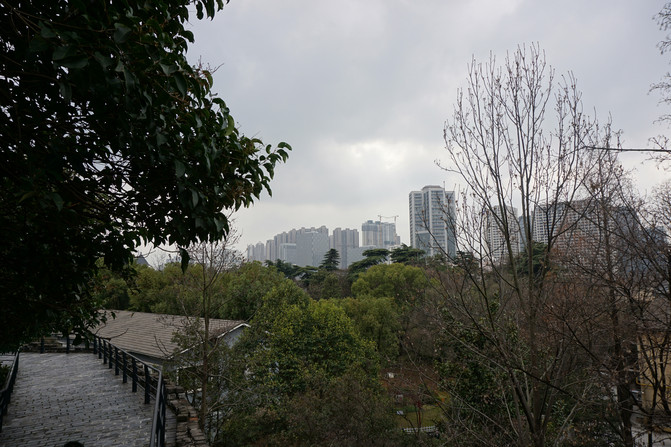
Walking for a while and looking back at the scenery is different. The distance along the way is different, the angle is different, and the scenery is also different.
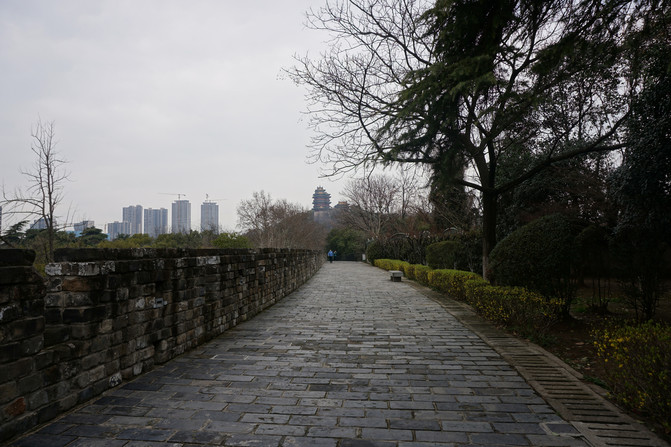
An academy relying on the city wall

The brick walls above the city wall were already somewhat damaged, so a one-meter-high guardrail was built.

The outer ring of the city wall is surrounded by black guardrails, which has another flavor

Walking along the city wall, you can see the spring color of Hydrangea Park under the city wall.

The East Lake in Hydrangea Park is sparkling with water and surrounded by green trees on the shores of the lake. The trees with small white flowers under the city wall are dotted with greenery and dotted the ancient city wall.
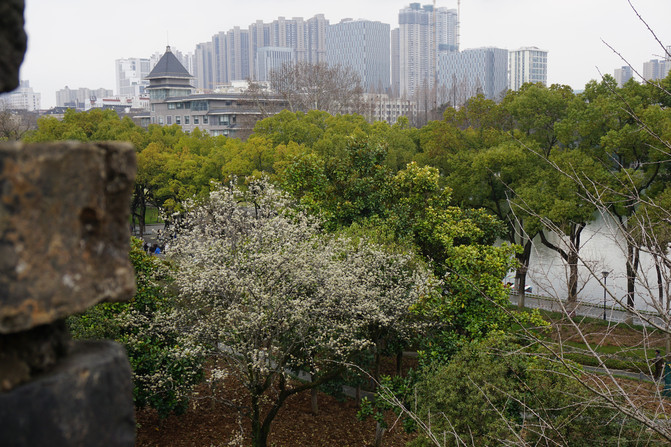
Looking north, the Yuejiang Tower in the distance is still in sight.

The brick characters on this section of the city wall are well protected and clearly visible.

The construction of the Ming City Wall and these wall bricks with characters are all imprints of the times. Through them, we can pry into diverse information on the political system, brick making craftsmanship, calligraphy and seal cutting art of the early Ming Dynasty.

After a journey of five to six hundred meters, I accidentally arrived at Jiangmen
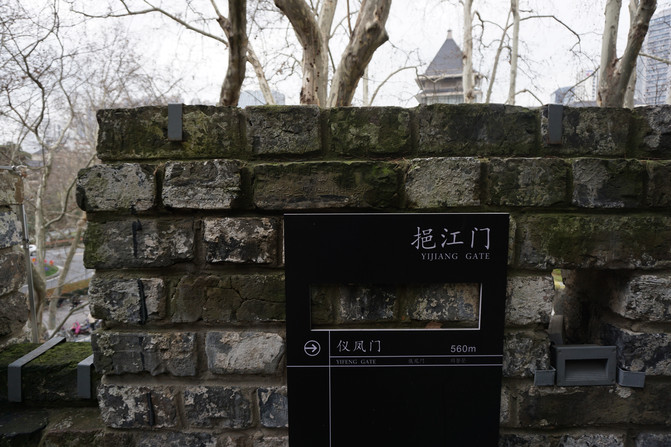
At your feet is the archway at the entrance of Hydrangea Park

There is a tower with double eaves and upturned corners with strong national style built on the gate of Yijiangmen. General Tie opened the door, but he could not enter or cross through it. He could only get off the tower from one side.

Yi Jiangmen
Address: Xiaguan District, Gulou District, Nanjing City
Tickets: Free
Get off the tower and come to Zhongshan North Road and see Yijiangmen from the front. The Yijiangmen Gate Tower is not the original tower of the Ming City Wall, but a later gate. In 1921 (the tenth year of the Republic of China), the city wall was cut open, and Zhongshan Avenue entered Nanjing City. It was the main transportation route for Zhongshan Wharf and Xiaguan Railway Station to enter the city. At that time, it was a single-hole gate. In 1929, in preparation for the Feng 'an Ceremony, it was changed to a three-hole arch. In 1930, a tower was built on Yijiangmen.
In 1937, when the Japanese army attacked Nanjing, the Yijiangmen Gate Tower was destroyed. The tower was rebuilt in 1945. Although Yijiangmen was not a gate of the Ming Dynasty, its spacious entrances and towering dysprosium towers all demonstrated the charm of this gate of the Republic of China.

Hongxing Tower Hotel on Zhongshan North Road

Cross Zhongshan North Road and come to the south side of the city gate. There is a small mountain road to return to the city wall.

The city wall is surrounded by Bazhan Park. Yijiangmen is actually a gate connecting Lion Rock and Bazi Mountain.

Returning to the city wall, you can see the TV tower in the distance.

The city wall is meandering on the edge of Bazi Mountain, with mountains on one side and soft moat water on the other side.

Accompanied by a pedestrian trail along the city wall, leisurely citizens stroll here.
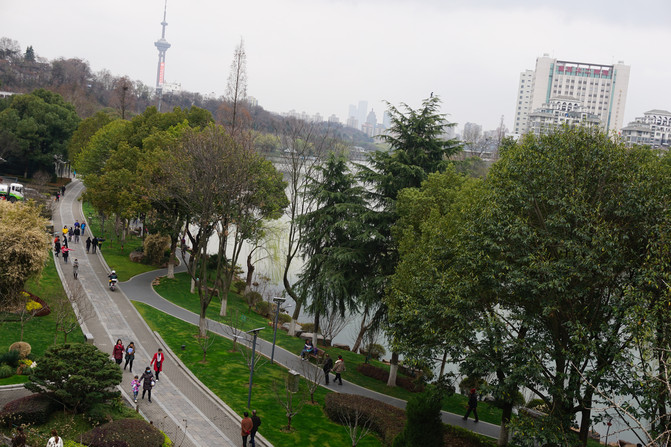
The city wall is integrated with Bazashan Park and is also a good place for citizens to relax.

This section of the city wall is surrounded by gable walls, and the walls turn along the mountains, winding and towering.

A row of blooming peach blossoms dresses up the green mountain brilliantly

From this position, you can see the turning of the mountains, the turning of the city wall and the turning of flowers. The beautiful curves extend smoothly.

The vicissitudes of the city wall, the modern buildings in the distance, and the pavilions on the top of the eight-character mountain are stacked on top of each other.
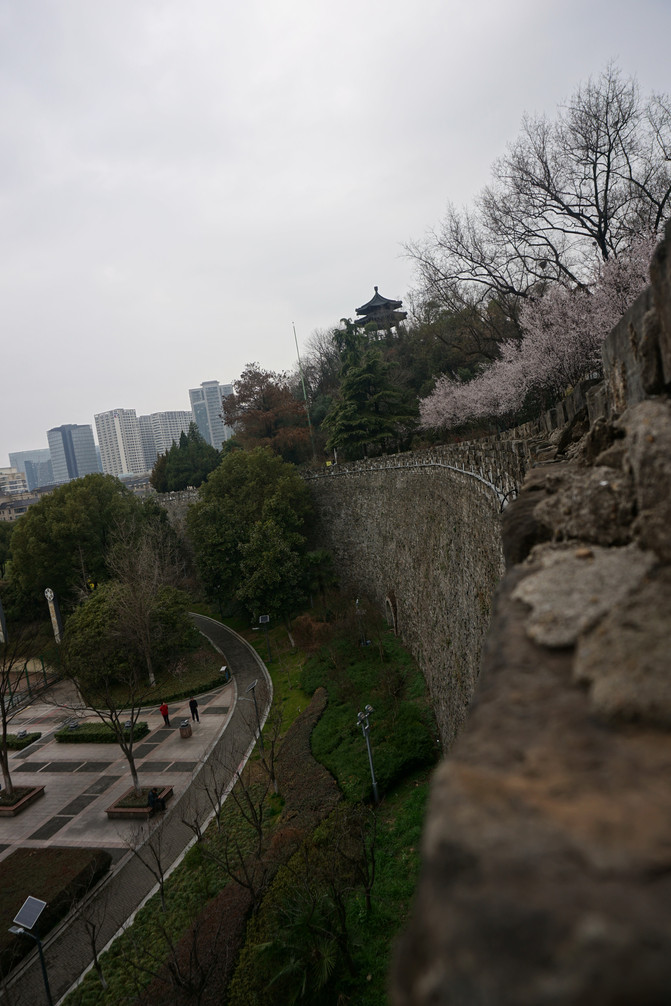
On the left side of the city wall is the evergreen Bazi Mountain, and outside the wall is a lush green belt.

Standing on the city wall and slowly enjoying it, each section has its own style. With the arrival of spring, the yang qi that has been hidden all winter is gradually released, and the colors of peach red willows are rendered on the background of nature.
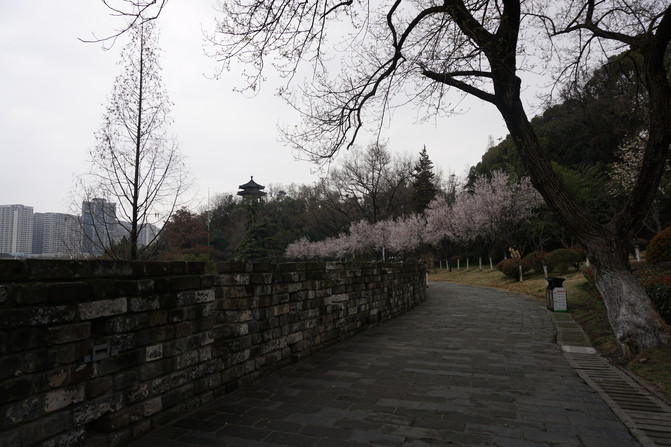
Overlooking the lake outside the city wall


The city wall of Yijiangmen continues south. The small Taoyuan under the root of the city wall that is accompanied by the city wall faces the Hydrangea Park, forming a narrow strip that goes south along with the Qinhuai River water. It is an open leisure green area with water in the city wall and beautiful mountains and forests.

Between the city wall and the moat is a large civil square. There are many facilities in the colorful square for children, young people, and old friends to take what they need and enjoy themselves. The park is very popular. Old people gather together to chat, young people run on the court, and children have fun in the sand pits.


Such a scenery belt allows us to choose to walk on the city wall or by the moat. Two parallel lines have different perspectives and different scenery.


This location looks back at the top of the Bazi Peak and the Yuejiang Tower in Lion Mountain further away. Starting from Yifeng Gate, you can pass through Yijiangmen, Hydrangea Park, Xiaotaoyuan. While traveling through a hundred years, you can also overlook the natural beauty on the city wall.


The ruthless time has carved deep or shallow marks on the city wall. Some of these city bricks are still intact and some have been damaged, but this does not damage the heavy temperament of the city wall at all. When I looked at this section of Baoshan City Wall, I felt what I felt was solid power.


Solid city walls are strength, and the Qinhuai River water creates a scene of combining strength and softness with tenderness.

Xiaotaoyuan (Yan Huagangmen)
Address: Yijiangmen Street, Gulou District, Nanjing City
Tickets: Free
Here is a new city gate-Huayangang Gate. This gate was built on October 1, 2007. In order to complete and open to traffic the west extension project of Chahar Road, a gate was built on the Ming City Wall at the foot of Dingshan.
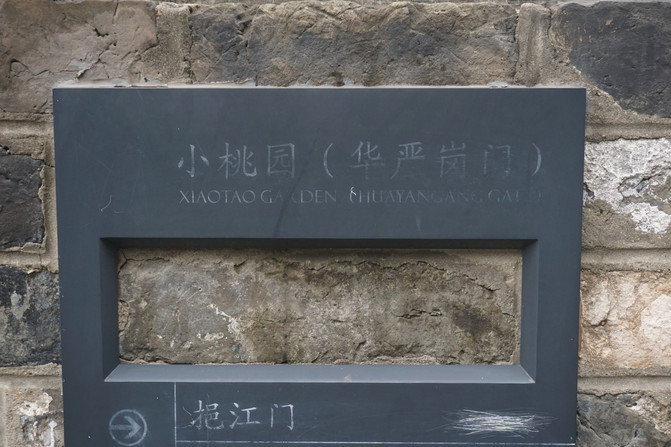

We did not go down the city wall to see the appearance of the city gate, but continued south along the city wall.

On the way, you can enjoy the scenery of northwest Nanjing from the city wall. The city wall is lined with mountains and parks. You can also overlook each other from multiple city gates.

Most beautiful trails have been built at the foot of the Nanjing City Wall to accompany the city wall. Not only can we choose to overlook the city wall, but we can also walk up the greenway next to the city wall and see the scenery with different visions. This feeling is like switching between history and modernity.


Cities, like people, must have their own vivid marks, and the ancient city walls have long become part of Nanjing people's lives. Nanjing people are proud of the Ming City Wall. People stroll here and children grow up by the city wall...
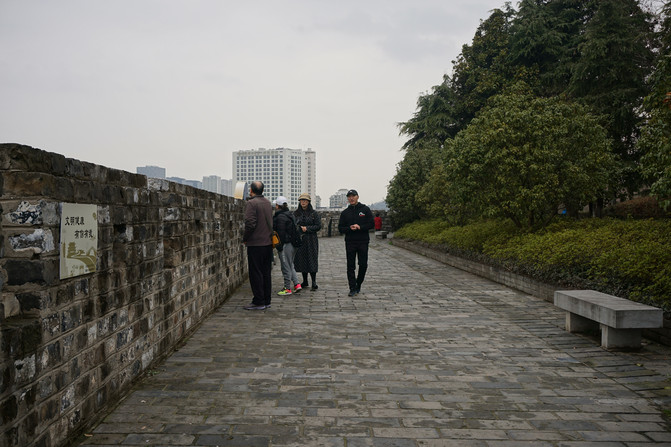
I like to walk on the city wall. Every brick on the city wall seems to tell the long history, allowing you to feel the ancient city with profound cultural heritage, ancient and profound. In a few days, the child will go north to study. Climbing the city wall today is the custom of walking the city wall on the 16th of the first lunar month. Secondly, it is also meant to be the meaning of climbing the city wall to start a new journey! Today, my child and I have made a new appointment. Every year, we will find a section of the city wall to walk around before he starts school and goes north. Measure with your footsteps, remember the beautiful city we live in, and remember this place that foreign enemies dare not easily set foot.

Close to Dinghuaimen, the city bricks have changed, and the city bricks a few steps forward are more interesting.

Soft flowers in the cracks in the city wall

Spring scenery on the city wall

When you reach here-Dinghuaimen, this is the southernmost tip of this section of the city wall. Along the way, from Yifeng Gate, Yijiangmen Gate, Huayangang Gate to Dinghuai Gate. Dinghuai Gate is one of the thirteen Ming Dynasty capital gates on the Ming City Wall of Nanjing. It is a single-hole gate with a gate ticket. In the 23rd year of Daoguang of the Qing Dynasty (1843), Dinghuaimen was stopped in use due to the sedimentation of the Outer Qinhuai River. In 1958, Dinghuimen, a city demolition movement that swept across the country, was demolished, and the place name is still in use today. Although it is now called Dinghuai Gate, it is no longer the concept of a gate we imagined.

You will reach Dinghuaimen Street when you get off the city wall. Standing at the intersection, you will see the towering Nanjing TV Tower on Shitoucheng Road.

The beautiful Sacha River and the scenery along it. The new green in early spring makes people feel tender in their hearts.

embellishment of small flowers

Today is a purposeful trip, a ritualistic trip. The section of the city wall in the northwest selected for "The 16th day of the first lunar month, walking through all diseases" was the child's idea. Only when I came did I realize that this is also a relatively long section of Nanjing's free city wall. Every day, a large number of nearby residents go to the city wall to exercise or take a walk to enjoy the scenery. The happiness index of nearby residents is extremely high. The Ming City Wall used a period of long-term persistence to create a broad-minded and inclusive Nanjing City. This is the Nanjing City Wall, Nanjing City, which is worth our steps to step on, measure, and understand.
Previous Article:Nanjing people look at Nanjing--stroll around Gaochun Old Street
